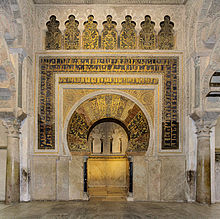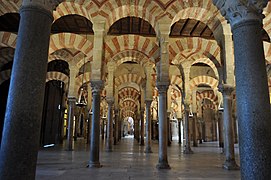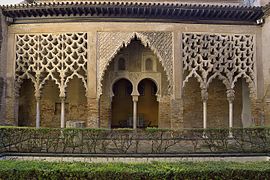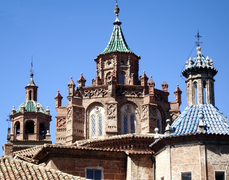Hispano-Muslim art
Hispano-Muslim art is a set of artistic styles and forms from the western Mediterranean basin, the result of the crossroads of influences from the Iberian Peninsula and the Maghreb during the Al-Andalus civilizations. These styles flourished between the 8th and 15th centuries during the Middle Ages, a historical period dominated by religious thought, and were often associated with the arts of Islam.
Features
Islamic art developed in al-Andalus (the Muslim part of the Iberian Peninsula) between the 8th century and 15th century. The death of Muhammad (632) produced a process of political and religious expansion of the Islamic civilization beyond the Arabian peninsula (conquered from North Africa), the Muslim invasion of the Visigothic kingdom (711) meant, in the artistic and culture, a change of orientation of the models, but also a syncretism of which the Arab civilization is characteristic. Islam's capacity for adaptation and synthesis results in a new artistic expression. When the Muslim irruption took place in Spain, the new settlers brought their conception of art with them; Actually, this was not yet fully configured, it can be said that Islamic art is a syncretism of elements taken from the various conquered countries: Persia, the Byzantine territories, the Visigothic kingdom and the Romans.
This art in the western part of their Empire, results in an Islamic art that mixes classical elements together with Islamic elements. Islamic art must be interpreted from a religious point of view, typical of a theocentric society such as the Muslim one, where political and religious power rests with the same person. This mentality is reflected in the artistic expression that reveals faith and its concept of divinity as well as the influence that the Koran, the holy book of Islam, exerts on the life of the believer.
Among the consequences of this religious conception of life, is that Islamic art is intimately linked to religion and this prohibits the representation of the human figure; we are before an iconoclastic art. Reality is deformed in geometric images, in stylized forms, and epigraphics (verses from the Koran written with straight or cursive lines), but never real or figurative, all of which produces a great development of ornamental resources: play of light and shadow, above all through lattices and a game of brightness achieved through the use of materials, and the repetitive arrangement of decorative elements that multiply to infinity.
The repetition together with the ornamental density produces an effect of mobility and spatial agitation that generate fantasy games and abstract forms. The interest in reflecting nature leads artists to master lines and colors. Basic elements of this decoration are: calligraphy, plant and geometric motifs. Two types of writing are differentiated: Kufic (angular and sober signs) and Nasjí: freer and more cursive features.
Given the religious limitation (Islamic aniconism) that affects sculpture and painting (despite which there are some examples), its main manifestation was Andalusi architecture (Hispanic-Muslim or Hispanic Moresque); although the sumptuary arts (or decorative arts or minor arts –Andalusi ceramics, eboraria, goldsmithing, textiles–) had an extraordinary development.
Islamic architecture like all its artistic production is eclectic. The buildings are usually low-rise and in harmony with the landscape. The materials used in the constructions are poor, such as brick, plaster, wood (lime, marble dust and plaster), which, being worked with great mastery, produce a very beautiful sensation. It is an architecture in which a great contrast can be seen between the simple and simple external appearance, and the richly decorated interiors. To speak of Islamic architecture is to speak preferably of cubic spaces in which some hemispheres stand out, the domes together with the use of supporting elements, columns and pillars that are slender, since the roofs they support are light. Notably, the reuse of elements from Visigothic churches were transformed into mosques, which implied the adoption and transformation of the horseshoe arch, in addition to polylobed arches and pointed horseshoe arches.
The most important monuments that have been preserved are the Mosque of Córdoba and the Alhambra in Granada. Muslim art even took Roman influences, reflected, for example, in the Mosque of Córdoba: in its construction, begun in the year 785 and which marked the beginning of Islamic architecture in the Iberian Peninsula, Roman and Visigothic columns were used and its arcades, by alternating red and white colors, recall those of the Roman aqueduct of Mérida; it was built using old materials and incorporating the double horseshoe arch as a solution to the cable-stayed arch. Andalusian architecture reached its peak with the construction of the Alhambra, the magnificent Nasrid royal palace, Granada's palace-fortress, with its open, cool space adorned in red, blue, and gold; the walls are decorated with stylized foliage motifs, Arabic inscriptions, and arabesque designs, with walls covered in glazed tiles.
Two peculiar artistic styles of the Spanish Middle Ages are closely linked to Andalusian art: Mozarabic art (that of Christians under Muslim rule, or those who emigrated from al-Andalus to the Christian kingdoms of the north, where they had a notable influence on the local pre-Romanesque) and Mudejar art (that of the Muslims under Christian rule, many of them specialized in construction crafts –masons, carpenters, stucco workers–, which characterized hybrid styles called Romanesque-Mudejar and Gothic-Mudejar, and left a great influence on transitional styles to the Spanish Renaissance—Hispano-Flemish, Plateresque, Elizabethan, or “Catholic Monarchs style” and “Cisneros style.” One of the best examples of lasting Moorish impact is the Real Alcázar in Seville.
Until 1492, when the Nasrid kingdom of Granada disappeared, peculiar cultural conditions were maintained in al-Andalus that differentiated it from both Eastern Islam and European art. But, at the same time, this geographical and cultural uniqueness was one of the factors that had a decisive impact on the awakening of Europe after the centuries of disunity and lethargy that followed the fall of the Western Roman Empire and the barbarian invasions.
The Muslim conquest did not mean the extinction of the Christian and Jewish communities. Some fled to the north, where they formed a redoubt of opposition to the new power established in Córdoba and, over time, would constitute the seed of what was later called the Reconquista; Others, the Christians who remained in Muslim territory, came to be known by the name of Mozarabs. Both this minority and the Jews enjoyed state protection, forming large communities in large cities such as Mérida, Toledo, Valencia, Córdoba, Seville, Granada, Almería, Málaga, etc.
Spanish Islamic architecture is of great importance as a creator of original forms, due to the role it plays in the diffusion of oriental forms and techniques in western Christian architecture. In fact, al-Andalus becomes a cultural bridge between East and West.
- Examples of Spanish-Muslim architecture
Emiral and Caliphate art
From an artistic point of view, the Andalusian emirate uses a style that does not differ too much from the rest of the Umayyad Caliphate. That is to say, the adequacy of formulas and elements of the cultures that had preceded them, in this case of the Roman and Visigothic world. At no time is there a literal repetition of motifs and forms; on the contrary, its intelligent incorporation and assimilation translates into a true creative explosion, originating the peak moment of caliphal art. In it, elements of the local Hispano-Romano-Visigothic tradition merge with oriental elements, both Byzantine, Umayyad and Abbasid.
The artistic buildings are centered, from the outset, around its capital, Córdoba, where a congregational mosque was built, destined to become the most important monument in the Islamic West. Among others, the works carried out during the reign of Abd al-Rahmán II stand out, a court that welcomed numerous artists, oriental fashions and customs; He promoted, among others, the construction of the Alcázar de Mérida as well as the minaret of the church of San Juan in Córdoba and he improved its walls and those of Seville. Caliph Abderramán III, following the oriental tradition (according to which each monarch, as a sign of prestige, should have his own palatial residence), decided to found the courtly city of Medina Azahara (Medina al-Zahra).
In the rest of the peninsular territory, the artistic flourishing promoted by the caliphate is also evident. Among those of a religious nature are the mosques, medersas or madrasahs and mausoleums. In the city of Toledo remains of its fortification can still be seen, as well as some vestiges that define its citadel, medina, suburbs and surroundings. Among them, the small mosque of Cristo de la Luz or Bab al-Mardum stands out. And works as significant as the rabida of Guardamar del Segura (Alicante), the castle of Gormaz (Soria) or the City of Vascos (Toledo).
The refinement prevailing in the Caliphate court led to the creation of all kinds of decorative objects that, under royal patronage, were translated into the most varied artistic expressions. Special mention should be made of the ivory works, among which are all kinds of meticulously carved everyday objects: jars and chests for storing jewellery, ointments and perfumes; mortars, cauldrons, caskets, jugs and glazed ceramic basins, etc. In the National Archaeological Museum, you can see the Zamora Boat, intended for the wife of al-Hakam II or the Leyre chest, which give good examples of this.
The monarchs, as in Baghdad and Cairo, created their own fabric or band factory, which gave rise to the beginning of the history of the production of embroidered silk fabrics in al-Andalus. The geometrical plant and figurative motifs are inscribed in medallions that form bands as they appear on Hisham II's veil or clamshell that, like a turban, covered his head and hung down to his arms.
There were also workshops in which bronze was worked, carved with figures representing lions and deer with their bodies covered in tangent circles evoking fabrics and used as fountain fountains. Its formal and stylistic parallelism with pieces from the Fatimids has led to controversy about the legitimacy of some of these pieces.
The ceramic has types of production known as green and manganese. Its decoration based on epigraphic and geometric motifs and a prominent presence of figurative motifs are achieved by applying copper oxide (green) and manganese oxide (purple).
Taifal art
The destruction of political unity led to the abolition of the Cordovan caliphate in 1031 and the creation of a mosaic of independent kingdoms that were called taifas (from tawaifs, parties, factions). The rivalries between them, claiming the inheritance of the prestige and authority of the Caliphate, constituted the dominant tone of the period. This situation was translated in the artistic field in the emulation of Cordovan models.
The palatine architecture sponsored by each of the monarchs is inserted in this context. One of the best testimonies is undoubtedly the Aljafería in Zaragoza, typologically related to the Umayyad palace in Msatta (Jordan). It has a tripartite organization where each of the sectors was dedicated to different functions. The central sector, for protocol use, is dominated by a rectangular patio whose smaller sides were occupied by pools, porticoes, and long rooms bounded at the ends by alcoves. This scheme derives, without a doubt, from the Cordovan palatine models. The repertoire of arches deployed in the building responds to this same tradition, among which we find from lobed, mixtilinear, semicircular and pointed horseshoe arches, to complex organizations of interlocking, superimposed and opposed arches. All of them are made with poor materials, but covered with plasterwork with plant, geometric and epigraphic motifs, seeking an effect of lavishness and apparent wealth.
The old citadels of the different kingdoms also underwent major renovations. In Malaga, a double walled enclosure was added with square towers and a palace to which correspond the remains of the so-called Granada Rooms. The old fortress of Granada, known as qadima (old), located on the Albaicín hill, was fortified with square and round towers and some curved gates were added, such as the Monaita gate and the New. Likewise, the city preserves some baths known as El Bañuelo, in the Carrera del Darro, organized into three rooms of which the central or warm one acquires, for reasons of use, larger dimensions. Very similar baths are preserved in Toledo, Baza and Palma de Mallorca. The Almería citadel was fortified with mud walls, and a palace was built inside, al-Sumadihiyya, surrounded by gardens. In the cases of Toledo and Seville, kingdoms that pushed hardest for the Cordovan heritage, dazzling testimonies of Arab chronicles about their palaces have been preserved, as well as few fragments that are generally out of context.
Like architecture, the sumptuary arts followed the Cordoba tradition although the prominence was acquired by other centers. Thus, the production of ivory was transferred to the Cuenca workshop while the prestige in textiles was acquired by the Almería workshop. As far as ceramics are concerned, a technique that had appeared during the Caliphate but which was now greatly developed was consolidated. It is about "cuerda seca" whose pieces are decorated with lines of manganese oxide forming different motifs that are filled with glass of different colors and sizes.
Almoravid art
The works carried out during the reign of the monarch Yusuf ibn Tasufin, still evidenced the austerity and lack of ornamentation imposed by his religious fervor. Formal rigor that his son Ali ibn Yusuf did not maintain, who, dazzled by the courtly refinement of the Andalusian taifas, sponsored the construction of several buildings decorated with the most beautiful elements.
The preferred support is the pillar, instead of the column. They adopt the horseshoe and lobed arch, to which they add horseshoe or tumid arches, trefoil lobed, mixtilinear and lambrequin arches formed, the latter, by small curves, right angles and pendent keystones. In relation to the development of the arches, they apply, from the salmer, a motif in "S" called serpentine, already used previously in the Aljafería de Zaragoza. The preferred system of roofs is gabled, they build wooden roofs and achieve a great development in Mudejar art, at the same time that they make extraordinary domed roofs. Some, represented by the dome of the mihrab of the Tlemcen mosque, will follow the Cordoba model: interlocking arches that leave the keystone free, although, in this case, they start from angular muqarnas proboscis and use openwork stucco accessories decorated with exuberant motifs. floral. From this work, which documents the introduction of the muqarna in the Maghreb, other types of domes called muqarnas appear, such as the one that can be seen in the Qarawiyyin mosque in Fez.
Artistic works continued to be linked to earlier traditions. The Almería textile workshop reached its zenith making the famous “attabi”. These fabrics are characterized by the use of softer colors with touches of gold forming double, tangent or linked circles, arranged in rows, inside which pairs of animals are embroidered. The similarity with the Sicilian fabrics allows both workshops to be confused. A similar problem is posed by the ivories, which contain ambiguous inscriptions that do not quite clarify which of the two workshops they belong to. Ceramics, for its part, continue to develop the technique of "partial dry rope" or "full" depending on whether the decoration covers the entire surface or part of it. At the same time, two new techniques applied to unglazed ceramics appeared: sgraffito and stamping, which became widespread in the Almohad period.
Almohad art
The return to the most extreme austerity led, even more quickly than in the case of its predecessors, the Almoravids, to one of the artistic moments of greatest splendor (see Almoravid art), particularly as regards to architecture. Almohad art continued the Almoravid trail, consolidating and deepening its typologies and ornamental motifs. They built with the same materials: tiles, plaster, mortar and wood. And they kept, as support, the pillars and arches used in the previous period.
Their mosques followed the model of the Tlemcen mosque, with naves perpendicular to the qibla wall. In them, a scheme was promoted in "I" through the use of muqarnas domes in the Tinmal mosque and in the Kutubiyya mosque in Marrakech. They are characterized by their square plan and their height made up of two towers, one of them houses another and, between them, a staircase or ramp runs, as in the case of the Giralda in Seville. The interior tower is made up of vaulted and superimposed rooms that will have a later impact on the construction of other Mudejar bell towers, especially those built in Aragon.
The palatial architecture introduces the crossed courtyards that had already made their appearance in Medina al-Zahra, but which is, at this time, when they acquire their greatest prominence. Its best testimony is found in the Alcázar of Seville, where the courtyard of the Casa de Contratación and another, currently underground, known as the Cross Garden have been preserved. or Baths of Doña María Padilla. This scheme will also be applied in the Nasrid and Mudejar patios. Another novelty appears in the Patio del Yeso of the Alcázar in Seville, and it will have a great impact. It consists of placing small openings or windows covered with stucco lattices that give access to a room and thus allow lighting and ventilation.
Military architecture undergoes a typological enrichment and its defensive effectiveness is perfected, which will have great significance, even for the Christian sphere. Complex doors with turns appear so that the attackers, when advancing, leave one of their flanks exposed; polygonal towers to deviate the angle of fire; albarranas towers separated from the walled enclosure but joined to it at the top by means of an arch, which makes it possible to increase their defensive effectiveness compared to a normal tower, such as the Torre de Espantaperros in Badajoz or the Torre del Oro in Seville; reinforced walls that run perpendicular to the walled enclosure in order to protect a water intake, a door, or avoid complete encirclement; barbicans or crenellated parapets and parapets.
In the field of decoration, they applied a repertoire characterized by sobriety, order and rationalism, which translates into the appearance of large motifs that leave free spaces in which geometric interlacings, smooth plant forms and the most new: the sebqa. Another architectural decoration that appears in this minaret and in the Kutubiyya mosque is ceramic, in which the tile technique is applied; that is to say cut pieces that, combined with each other, make up a decorative motif. On other occasions these artistic manifestations unite the ornamental character with the functional one.
Works of art from this period are less represented due to the confusion between the different artistic periods. This is what happens, for example, with the fabrics, which are not easily distinguished from the Mudejar ones: they show a practical absence of figurative motifs while the geometric and epigraphic decoration increases based on the insistent repetition of Arabic words such as "blessing" and "happiness". As for metallic elements, the ewers stand out, representing figures of animals decorated with chiseled plant incisions.
Nazari art
Nasrid art is a style that emerged in the late al-Andalus period in the Nasrid kingdom of Granada. The two paradigms of it are made up of the palaces of the Alhambra and the Generalife.
Military architecture develops the same systems generated in the previous era, giving it greater complexity. Palatial architecture employs two types of patio organization: one, the monoaxial patio, Patio de los Arrayanes or Alberca, and another, the crossed patio, patio of the Lions. The rooms linked to them respond, again, to two typologies: an elongated one whose ends are the bedrooms, and another square surrounded by the rooms, for example, the Sala de la Barca and the Hall of the Two Sisters. The few vestiges of religious architecture allow us to think of mosques that follow the Almohad model, with naves perpendicular to the “qibla” wall. Perhaps the only notable novelty comes from the use of marble columns when the building is of a certain importance.
Regarding the ornamental repertoire, they use a decorative profusion that masks the poverty of the materials, they use everything from tiled plinths and stucco plasterwork, to painted decoration like the one preserved in the vault of the Sala de los Reyes. The column with a cylindrical shaft and the capital with two bodies are characteristic, one cylindrical decorated with bands and the other cubic with ataurique. The preferred arches are the cambered and angled semicircular ones. The wooden ceilings alternate with muqarnas vaults made with stucco like those of the Hall of the Two Sisters or the Hall of the Abencerrajes. Likewise, to the usual ornamental motifs (geometric, vegetal and epigraphic), the Nasrid coat of arms is added, which will be generalized by Mohamed V.
In the sumptuary arts, ceramics with metallic reflections and silk fabrics stand out, to which can be added bronzes, inlays and weapons. Luxury ceramic, known as "metallic reflection" or "golden slab" It is characterized by subjecting the last cooking to a very low "oxygen" and lower temperature. With this procedure, the mixture of gold and copper sulfide used in the decoration reaches oxidation, reducing the metallic shine. It was also common to add cobalt oxide, which achieved blue and gold tones. The fabrics were characterized by their intense color as well as by the motifs, identical to those used in architectural decoration.
Mudejar art
Mudejar art took place between the 12th century and the XVI, and was an autochthonous and exclusively Hispanic phenomenon, carried out by the Mudejars, Christians and Moors. Basically, it is a style for Christians but it incorporates Hispano-Muslim influences, elements or materials.
This art was influenced by the border situation in continuous movement. The Gothic style was established in the north of the peninsula and, as the reconquest progressed, it progressively conditioned the Mudejar style. The subsequent conquest of al-Andalus led to a younger Mudejar with direct influences from traditional architecture. The builder, in his role as a specialized mason, used simple materials such as tiles, plaster, plaster, masonry, wood, etc., as basic raw material to create a work full of imagination. As a master builder and "expert" in all kinds of constructions, and without competition among his Christian peers, the builder descended in the architectural hierarchy but continued to be indispensable in the works of churches, synagogues, fortifications, palaces, fountains, etc.
Schools
In Mudejar art, two different schools stand out:
- Aragon: With a very characteristic personality, it surprises the color that receives the use of tiles in the exteriors and the countless resources that extract them.
- Andalusia: In Cordoba the use of the stone is maintained, while in Seville the tile predominates, the almohad forms and the construction of mausoleums.
The last style would be Neomudéjar, as the final and evolutionary phase over time.
Disciplines
- Crafts
- Graphic arts
- Ceramics
- Dance
- Sculpture
- Literature
- Music
- Painting
Contenido relacionado
Sayonara (film)
Francis Drake
Koine


















